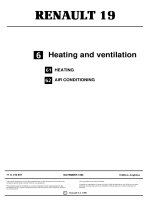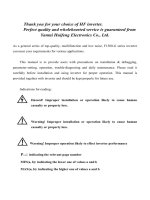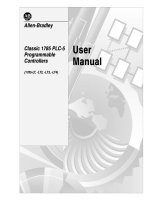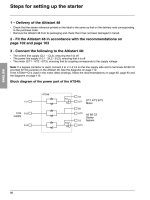F1500 users' manual
Bạn đang xem bản rút gọn của tài liệu. Xem và tải ngay bản đầy đủ của tài liệu tại đây (1.45 MB, 87 trang )
Thank you for your choice of HF inverter.
Perfect quality and wholehearted service is guaranteed from
Yantai Huifeng Electronics Co., Ltd.
As a general series of top-quality, muiltifunction and low noise, F1500-G series inverter
can meet your requirements for various applications.
This manual is to provide users with precautions on installation & debugging,
parameter-setting, operation, trouble-diagnosing and daily maintenance. Please read it
carefully before installation and using inverter for proper operation. This manual is
provided together with inverter and should be kept properly for future use.
Indications for reading:
Hazard! Improper installation or operation likely to cause human
casualty or property loss.
Warning! Improper installation or operation likely to cause human
casualty or property loss.
Warning! Improper operation likely to effect inverter performance
P
××
:
indicating the relevant page number
MIN(a, b): indicating the lower one of values a and b
MAX(a, b): indicating the higher one of values a and b
Contents
CONTENTS
I. Operation in Safety ……………………………………………………………1
II. Products ……………………………………… …………………………… 3
2.1 Models & Nameplate ……………………………………………………… 3
2.2 Products List…………….……………………………… ………………… 3
2.3 Appearance .……………………………………………………………….5
2.3.1 Plastic Housing
2.3.2 Metal Housing
2.4 Performance Indexes ……………………………………………………… 7
III. Installation & Wiring ………………………………………… 8
3.1 Installation …….…………………………………………………………….8
3.1.1 Installation Direction & Space
3.1.2 Installation Environment
3.1.3 Exterior Dimensions & Installation Dimensions
3.2 Wiring ……………………………………………………………………….10
3.2.1 Standard Wiring Layout
Wiring Diagram 1 ……………………………………………….… 11
Wiring Diagram 2 ………………………………………………… 12
3.2.2 Input & Output Terminals
IV. Operation & Display ………………………………………………………… 17
4.1 Keypad Control Unit ………………………………………………… ….18
4.1.1 Operation Panel Instruction
4.1.2 Keypad Instruction
4.2 Function Parameters Setting…………………………………………… ….19
4.3 Function Code Grouping…………………………………………………….20
4.4 Panel Display …………………………………………………………….….20
V. Functions & Parameters Instruction ……………………………………….… 21
5.1 Basic Parameters…….………………………………………………………21
I
Contents
5.2 Operation Control Parameters ……………………………………… 25
Use of Jumper Terminals ……………………………………………… 27
5.3 Multi-Speed Parameters ………………………………………………… 31
5.4 Programmable Input & Output Terminal Parameters………………… 34
5.4.1 Programmable Input Terminals
5.4.2 Programmable Output Terminals
5.4.3 Special Output Terminals
5.5 V/F Control Parametes ……………………………………………… …37
5.5.1 V/F Compensation & Carrier-Wave Frequency
5.5.2 Braking Parameters
5.5.3 Stalling Setting
5.6 PI Setting Parameters ………………………………………………… 40
5.7 Timing Control & Definable Protection Parameters ………………….….42
5.7.1 Timing Control
5.7.2 Definable Protection
-
Undervoltage Protection and Overload Protection
5.7.3 Malfunction Recording
5.8 Analog signal Parameters………… …………………………… … 44
5.8.1 Analog signal Input
5.8.2 Pulse Input
5.9 Communication Parameters ………………………………………… 45
VI. Simple Mode of Operation ………………………………………………… 46
6.1 Operation Mode Block Diagram ………………………………… … 46
6.2 Speed Control Mode ………………………………………………… 47
Appendix 1
Trouble Shooting…………………………………………….… …55
Appendix 2
Function-Codes Zoom Table………………………….……………58
Appendix 3
Selection of Braking Resistor and Braking unit ……….………… 67
Appendix 4 485 Communication Control Box ………………………………….68
II
Operation in Safety
I. Operation in Safety
Hazard!
Inverter is not allowed to install in a place with flammable or explosive gases in case explosion may
be triggered off.
Only competent professionals can handle installation, wiring, operation and maintenance on inverter.
Inverter grouding terminal PE
( )
shall be well connected to earth (grounding impedance not
more than 4Ω).
Shortcircuit is not allowed between common point (CM) and reference point (GND or AGND) for
inverter’s internal power supply and input zero line or inverter’s own “N” teminal.
Make sure that wiring is properly connected and cover-board is well fixed prior to inverter switch-on;
Do not touch inveter’s charged terminals with hands after it is swiched on.
Swich off before conducting any wiring or maintenance.
No maintenance is allowed within the first 10 minutes after switch-off or when DC bus voltage
exceeds 36V. Do not touch internal circuit or components.
Warning!
Make sure for a proper input voltage with inverter before it is connected with power.
Do not drop such metal objects as screwdriver or screw into inverter.
Do not install inverter in a place with direct sunlight. Do not stem inverter’s vent.
Do not connect input power to Teminals U, V, W or PE, P, B (N).
No direct connection of braking resistor to Terminal P or N.
Control loop wiring shall be separate from power loop wiring to avoid possible interference.
Warning!
♦
Please read this manual carefully before any operation on inverter.
♦
Inverter should not be stored or installed where there is strong vibration, strong erosion, heavy
dust, high temperature or greater humidity.
♦
Regular check shall be required for a proper wiring with inverter’s input and output, and to make
1
Operation in Safety
sure that the other wirings of the equipment are not aging.
♦
Check is required for motor insulation resistance before installation and operation.
♦
Extra cooling measures shall be necessary if motor often runs at low speed.
♦
Braking resistor or braking unit shall be adopted to avoid frequent over-voltage or over-current in
case of negative-torque energy feedback.
♦
Neither variable resistor or capacitance should be connected to inverter’s output to improve
power factor
。
Do not install a breaker between inverter’s output and motor. Should a breaker
have to be installed, it shall be ensured that it works only when inverter output current reads
zero.
♦
F1500-G inverter has a safety level of IP20.
♦
Cleaning is recommended on inverter’s internal components and radiator after it is in use for 1~3
months. Should it not be used for a long time, inverter should be switched on at a certain interval
(better one month).
Install&wiring
II. Products
2.1 Models & Nameplate
Product model is interpreted as below (taking for instance the single-phase 1.5KW inverter with internal
braking unit)
F1500-G series inverter’s nameplate is illustrated as Fig 2-2 (taking the single-phase 1.5KW inverter for
instance).
AC: alternating current input.
1PH: single-phase input. 220V and 50/60Hz stands for rated
input voltage and frequency
3PH: three-phase output. 1.5KW and 7A stands for inverter’s
rated power and rated output current while 0
~
220V, inverter’s
output voltage range.
0.00
~
400.0Hz: output frequency range Fig2-2 Nameplate Illustration
Fig 2-1 Product Model Illustration
F1500 - G 0015 X S2 B
Structure Mode Code
B : Plastic Housing
C : Metal Hanging |Type
D : Metal Cabinet Type
Input Voltge Type
S2 : single-phase 220VAC input
T2 : three-phase 220VAC input
T3 : three-phase 380VAC input
Internal Braking unit Code
Applicable Motor Power (1.5KW)
General-Purpose Type
Product Series
3
Install&wiring
2.2 Product List
F1500-G series inverter’s power range: 0.2
~
110KW. For main information, refer to Table 2-1.
For inverter’s external dimensions and installation dimensions, please refer to 3.1.3 (P
9
).
Table 2-1
F1500-G Product List
Models Rated Input
Voltage
(
V
)
Rated Output
Current (A)
Structure
Code
Applicable
Motor
(KW)
Remarks
F1500-G0002XS2B
~
220 (single-phase) 1.0 B1 0.2 Single-Phase Inverter
(with internal braking
unit)
F1500-G0004XS2B
~
220 (single-phase) 2.5 B1 0.4
F1500-G0007XS2B
~
220 (single-phase) 4.5 B2 0.75
F1500-G0015XS2B
~
220 (single-phase) 7.0 B2 1.5
F1500-G0022XS2B
~
220 (single-phase) 10.0 B3 2.2
F1500-G0037XS2B
~
220 (single-phase) 17.0 B5 3.7
F1500-G0002XT2B
~
220 (three-phase) 1.0 B2 0.2 Three-Phase 220V
Inverter
(with internal braking
unit)
F1500-G0004XT2B
~
220 (three-phase) 2.5 B2 0.4
F1500-G0007XT2B
~
220 (three-phase) 4.5 B2 0.75
F1500-G0015XT2B
~
220 (three-phase) 7.0 B2 1.5
F1500-G0022XT2B
~
220 (three-phase) 10.0 B3 2.2
F1500-G0037XT2B
~
220 (three-phase) 17.0 B5 3.7
F1500-G0002S2B
~
220 (single-phase) 1.0 B0 0.2 Single-Phase Inverter
(without internal
braking unit)
F1500-G0004S2B
~
220 (single-phase) 2.5 B0 0.4
F1500-G0007S2B
~
220 (single-phase) 4.5 B0 0.75
F1500-G0015S2B
~
220 (single-phase) 7.0 B2 1.5
F1500-G0022S2B
~
220 (single-phase) 10.0 B3 2.2
F1500-G0004T3B
~
380 (three-phase) 1.2 B3 0.4 Three-phase inverter
(with internal braking
unit)
F1500-G0007T3B
~
380 (three-phase) 2.0 B3 0.75
F1500-G0015T3B
~
380 (three-phase) 4.0 B3 1.5
F1500-G0022T3B
~
380 (three-phase) 6.5 B3 2.2
F1500-G0037T3B
~
380 (three-phase) 8.0 B4 3.7
Install&wiring
F1500-G0040T3B
~
380 (three-phase) 9.0 B4 4.0
F1500-G0055T3B
~
380 (three-phase) 12.0 B5 5.5
F1500-G0075T3B
~
380 (three-phase) 17.0 B5 7.5
F1500-G0110T3C
~
380 (three-phase) 23 C2 11
F1500-G0150T3C
~
380 (three-phase) 32 C2 15
Table 2-1 Continued
F1500-G Product List
Models Rated Input
Voltage
(
V
)
Rated Output
Current (A)
Structure
Code
Applicable
Motor
(KW)
Remarks
F1500-G0185T3C
~
380 (three-phase) 38 C3 18.5 three-phase inverter
(without internal
braking unit)
F1500-G0220T3C
~
380 (three-phase) 44 C3 22
F1500-G0300T3C
~
380 (three-phase) 60 C4 30
F1500-G0370T3C
~
380 (three-phase) 75 C5 37
F1500-G0450T3C
~
380 (three-phase) 90 C5 45
F1500-G0550T3C
~
380 (three-phase) 110 C6 55
F1500-G0750T3C
~
380 (three-phase) 150 C7 75
F1500-G0900T3C
~
380 (three-phase) 180 C8 90
F1500-G1100T3C
~
380 (three-phase) 220 C8 110
F1500-G0750T3D
~
380 (three-phase) 150 D3 75
F1500-G0900T3D
~
380 (three-phase) 180 D4 90
F1500-G1100T3D
~
380 (three-phase) 220 D4 110
2.3 Product Appearance
Exterior structure of F1500
-
G series inverter is classified into plastic and metal housings. Plastic housing is
shaped by mould pressing with hi-quality polymeric carbon, nice and strong with good tenacity; metal
housing adopts advanced process of exterior plastic powder spraying, glossy in color and elegant in
appearance.
2.3.1 Plastic Housing Appearance
Appearance and structure components are indicated as in Fig 2-3, taking F1500
-
G0055T3B for an instance.
5
Install&wiring
2.3.2 Metal Housing Appearance
Appearance and structure components are indicated as in Fig 2-4, taking F1500
-
G0220T3C for an instance.
Detachable one-side door-hinge structure is adopted for front panel for a convenient wiring and maintenance.
1—Keypad Control Unit
2—Vent
3—Dust Cover
4—Radiator
5—ControlTerminal
6—Power Terminal
7—Nameplate
8—Mounting Hole
Fig 2-3 Plastic Housing Structure
1
2
3
4
5
6
7
8
1
2
2
图
1-
2
图
牌
3
4
5
7 8
9
10
6
Fig 2-4 Metal Housing Structure
1.Keypad Control Unit
2.Front Panel
3.Vent
4.Body
5.Mounting Holes
6.Mounting Screw
7.Nameplate
8.Power Terminal
9.Control Terminal
10.Outlet Hole
Install&wiring
2.4 Performance Indexes
Items Descriptions
Input Rated Voltage thee-phase 380V±15%
single-phase 220V±15%
(
three-phase
220V±15%
)
Rated Frequency 50/60Hz
(
±5%
)
Output Rated Voltage thee-phase 0
~
380V; three-phase 0
~
220V
Frequency Range 0.00
~
400.0Hz (frequency resolution ratio0.01Hz)
Overload Capacity 150
%
60S
Control
Mode
Frequency Setting
Accuracy
Digit Setting: 0.01Hz, Analog signal Setting: Max Frequency×0.4
%
Setting Mode optimized space vector control
V/F Curve 3 kinds of V/F curves. To select and set beeline V/F curve, polygonal
line V/F curve and square V/F curve as per load
Torque Promotion Manual setting torque promotion within 1
~
15
%
Automatic Voltage
Setting
Automatic setting output voltage to meet input power fluctuation
within certain range
Braking Mode DC Braking
+
Optimized Energy-consumption Braking
PI Adjusting With built-in PI adjuster for automatic control
Jogging Jogging Range: 0.00
~
400.0Hz
Automatic Circular
Running
User will program output frequency mode as per process
requirements
7
Install&wiring
Operation
Functin
Frequency Setting Digit frequency setting, keypad “▲
/
▼ ” keys setting, “UP” and
“DOWN” terminals setting;
Keypad potentiometer or external analog signal (0
~
10V, 0
~
20mA)
setting;
Analog channel compound operation setting;
Multi-stage speed control and coding speed control;
485 communication control box / computer setting.
Start/Stop Control Control over keypad, 485 communication control box, terminals and
computer
Protection
Function
Input out-phase, input undervoltage, over-voltage, over-current, inverter overload, motor
overload, overheat, current check trouble, peripheral equipment trouble, user password
error/exterior interference, contactor monitoring.
Display LED nixie tube showing present output frequency, present rotate-speed, present output
current, present output voltage, final axis linear-velocity, exterior pulse count-value, types of
error, function-code parameters and operation parameters;
4 LED indicators showing the current working status of inverter.
Environment
Conditions
Equipment Location Free of tangy caustic gases or dust
Environment Temperature -10℃
~
+50℃
Environment Humidity Below 90% (no water-bead coagulation)
Vibration Strength Below 0.5g (acceleration)
height above sea level Below 1000 meters
Applicable
Motor Power
0.2
~
110KW
III. Installation & Wiring
3.1 Installation
3.1.1 Installation Direction & Space
Install&wiring
For better heat radiation of inverter, it should be installed perpendicularly ( as shown in Fig 3-1) while
ventilation space shall be secured in the surroundings. For clearance dimensions for installation of inverter,
refer to Table 3-1 (recommended).
Table 3-1
Clearance Dimensions
3.1.2 Installation Environment
♦
No drenching, dripping, steam, dust or oily dust; no caustic, flammable gases, liquid; no metal
particles or metal powder.
♦
Environment temperature: within -10
℃~
+50
℃
.
♦
Environment relative humidity: below 90%, without water-bead coagulation.
♦
No strong electromagnetic interference.
♦
Vibration strength: below 0.5g (acceleration).
♦
Ventilation should be secured should inverter be installed inside a control cabinet.
Inverter Type Clearance Dimensions
Hanging Type(<22KW) A≥150mm B≥50mm
Hanging Type(≥22KW) A≥200mm B≥75mm
Cabinet Type(75~110KW) C≥200mm D≥75mm
A
B B
A
inverter
C
D D
inverter
trench
Hanging Type
Cabinet type
Fig 3-1 Inverter Installation Illustration
9
Install&wiring
3.1.3 Extenal Dimensions & Installation Dimensions
Table 3-2
F1500-G Product Dimension List
Structure
Code
External Dimensions
(A×B×H)
Installation Dimensions
(W×L)
Mounting
Screws
Remarks
B0 105×150×120 94×139 M4
Plastic Housing
Hanging Type
B2 125×140×170 116×161 M5
B3 143×148×200 132×187 M5 Plastic Housing
Hanging Type
B4 162×150×250 145×233 M5
B5 200×160×300 182×282 M6
C2 260×250×380 230×356 M6 Metal Hanging
Type
C3 265×225×440 235×410 M6
C4 310×255×500 286×480 M6
C5 355×278×560 320×530 M6
C6 405×310×633 370×600 M10
C7 465×320×680 430×650 M12
D7 600×500×1650 375×282 M16
Metal Cabinet
Type
D8 600×500×1780 450×300 M16
Install&wiring
3.2 Wiring
3.2.1 Standard Wiring Diagram
Warning!
●
Control loop wiring shall be separate from main loop wiring, and should never be laid in the same
wiring duct to avoid any possible interference.
●
Control wiring should adopt shielded split-conductor, with section-area of 0.3
~
0.5mm
2
for Lead,
but signal wire should not be too long.
Wiring mode for inverter’s main loop and control loop are indicated as in the followings: Fig 3-3
standard wiring diagram for single-phase inverter (including three-phase 220 VAC input inverter).
Fig 3-4 standard wiring diagram for three-phase inverter.
Note: Braking resistor and braking unit are both optional. Refer to Appendix 3 (P
70
) for standards of
optionals.
Wiring Diagram 1
Fig 3-2 Dimension Code Illustration
Main Loop Output
Ctrol Loop Input
Ctrol Loop Output
Note 1
Note2
TA
TC
TB
Relay output
12A 125VAC
7A 250VAC
7A 30VDC
1 2 34
1
2
3
~
22
0
V
S
T
O
P/
R
U
N
F
W
D
R
E
V
2.2KΩ0
~
20mA
+10VAN1AN2GNDOP8OP7OP5OP4
OP3
OP2
OP1
CMOP6
▲▼
Stop Reset
RUN FWD DGT FRQ
J
OUT
24V
CM
GNDFM
GND
IM
Ammeter
P
B
Braking
Resistor(optional)
~ 220V
L1
L3
L2
W
V
U
PE
M
J4
I2
U2
J3
I1
U1
11
Install&wiring
Wiring Diagram 2
Fig 3-3 Standard Wiring Layout for Single-Phase Inverter
Main Loop Input
Shielded Wire
(metal layer clinging to Shielded
duct should be connected with GND)
RS-485
Serial communication
1
2
3
~
22
0
V
S
T
O
P/
R
U
N
F
W
D
R
E
V
Mode
Set
Run
Frequency
meter
J2
AN1
Vk
Note3
Braking unit (Optional)
OP8
OP7
OP5
OP4
OP3
OP2
OP1
CM
+10V
AN1
AN2
GND
OP6
~ 380V
R
T
S
Brake Resistor
(Optional)
(
N
)
P
B
P+
Reactor (Optional)
Short circuited slice
Note 4
W
V
U
PE
M
Install&wiring
Notes:
Note 1. The broken line in Wiring Diagram 1 only applies for inverter with built-in braking unit, with
Terminals P and B connected to braking resistor.
Note 2. “L3” specified in “=” in Wiring Diagram 1 is only used in three-phase AC220V input inverter.
Single-phase 220V input inverter is only connected to L1 and L2.
Note 3. “J2” jumper terminals are not available for single-phase inverter without built-in braking unit
and three-phase 11
~
110KW inverter
,
keypad potentiometer analog-signal (Vk) selection is set
by function code F204 (F204=10
—
P
27
).
Fig 3-4 Standard Wiring Diagram for Three-Phase Inverter
Main Loop Input
Main Loop Output
Ctrol Loop Input
Ctrol LoopOutput
GND
FM
Frequency
Meter
GND
IM
Ammeter
TA
TC
TB
Relay Output
12A 125VAC
7A 250VAC
7A 30VDC
1
2
3
~
22
0
V
S
T
O
P/
R
U
N
F
W
D
R
E
V
2.2KΩ
0
~
20mA
RS-485
1 2 34
Serial Communication
Mode
▲
Set
▼
Run
Stop Reset
RUN FWD DGT FRQ
J4
I2
U2
J2
AN1
Vk
J3
I1
U1
Note3
J
OUT
24V
CM
Shielded Wire
(metal layer clinging to Shielded
duct should be connected with GND)
13
Install&wiring
Note 4. Terminals P and B in Wiring Diagram 2 are connected to braking resistor while Terminals P
and N are connected to braking unit, Terminals P+ and P, to reactor, as per main loop terminals.
3.2.2 Input & Output Terminals
1
)
Power Terminals: Power terminals of various models are shown as follows:
a) Structure of main loop terminal for single-phase 0.2
~
2.2KW inverter without built-in braking unit;
a)
b) Structure of main loop terminal for 0.2
~
3.7KW inverter with built-in braking unit: for single-phase
220V input, connected to L1 and L2; and three-phase 220V input, to L1, L2 and L3;
b)
c) Structure of main loop terminal for three-phase 0.4
~
15KW inverter with built-in braking unit;
c)
d) Structure of main loop terminal for three-phase 18.5
~
110KW inverter without built-in braking unit;
d)
Table 3-3
Main Loop Terminals Description
Terminals Terminal
Marking
Terminal Function Description
Power Input
Terminal
R, S, T Three-phase 380V AC input terminal
L1, L2, L3 For single-phase 220V AC input, connected to L1 and L2;
For three-phase 220V AC input, connected to L1, L2 and L3 (Note: no
“L3” terminal for single-phase inverter without built-in braking unit).
Inverter Output
Terminal
U, V, W Inverter power output terminal, connected to motor.
Terminals Terminal
Marking
Terminal Function Description
PE L1 L2 U V W
PE R S T P B U V W
PE R S T P+ P N U V W
PE L1 L2 L3 P B U V W
Install&wiring
Grounding
Terminal
PE Inverter grounding terminal or connected to ground.
Braking Terminal P, B External braking resistor (Note: no Terminals P or B for inverter without
built-in braking unit).
P, N DC bus-line output, externally connected to braking resistor
P connected to input terminal “P” of braking unit or terminal “+”, N
connected to input terminal of braking unit “N” or terminal “
-
”.
P, P+ Externally connected to reactor
Table 3-4 Wiring Recommended for Input/Output Loop
Inverter Model Lead Section Area (mm
2
)
F1500-G0002S2B/ F1500-G0002XS2B / F1500-G0002XT2B 1.5
F1500-G0004S2B/ F1500-G0004XS2B / F1500-G0004XT2B 1.5
F1500-G0007S2B/ F1500-G0007XS2B / F1500-G0007XT2B 2.5
F1500-G0015S2B/ F1500-G0015XS2B / F1500-G0015XT2B 2.5
F1500-G0022S2B/ F1500-G0022XS2B / F1500-G0022XT2B 2.5
F1500-G0037XS2B /F1500-G0037XT2B 4.0
F1500-G0004T3B 1.5
F1500-G0007T3B 1.5
F1500-G0015T3B 2.5
F1500-G0022T3B 2.5
F1500-G0037T3B 2.5
F1500-G0040T3B 2.5
F1500-G0055T3B 4.0
F1500-G0075T3B 4.0
F1500-G0110T3C 6
F1500-G0150T3C 10
F1500-G0185T3C 16
15
Install&wiring
F1500-G0220T3C 16
F1500-G0300T3C 25
F1500-G0370T3C 25
F1500-G0450T3C 35
Continued Wiring Recommended for Input/Output Loop
Inverter Model Lead Section Area (mm
2
)
F1500-G0550T3C 35
F1500-G0750T3C 60
F1500-G0900T3C 60
F1500-G1100T3C 60
Warning! : Power terminal shall be tightly secured!
2) Control Terminal: Terminals of various models are structured as follows:
A) Control terminal for single-phase 1.5KW, 2.2KW (without built-in braking unit), single-phase 0.2
~
2.2KW (with built-in braking unit) and three-phase 0.75
~
2.2KW inverters;
A
)
B) Control terminal for single-phase 0.2
~
0.75KW inverter (without built-in braking unit);
C)
Control terminal for single-phase 3.7KW, three-phase 0.4KW and 3.7
~
110KW inverter;
Warning! : Fastening moment for control terminal: 5kgf.cm.
Table 3-5
Control Terminal Functions
Classificat
ion
Terminal Mfg
Function
Function Description Specification
OUTOP5OP6OP7OP810VAN1(A)GNDAN2IM
24VOP1OP2OP3OP4CMTATBTCFM
B
)
TATBTCOUT24VCMOP1OP2OP3OP4OP5OP6OP7OP810VAN1AGNDFMIMAN2
C
)
OUT24VCMOP1OP2OP3OP4OP5OP6OP7OP810VAN1GNDFMIMAN2TATBTC
Install&wiring
Output
signal
of
Switching
Value
OUT Operation
Indication
Signal
Indicating inverter’s operation status.
OUT: collector open-circuit output with
output current not more than 100mA.
Refer to Function Code
F416
、
F417 (P
36
) for other
function settings.
TA Fault
Indication
Signal
Indicating inverter’s fault status.
TC: common point; TB-TC: normally
closed contact
,
TA-TC: normally open
contact. Contact spec:12A
125VAC
7A
250VAC
7A
30VDC
TB
TC
Continued
Control Terminal Functions
Classificat
ion
Terminal Mfg
Function
Function Description Specification
Analog
Output
Signal
FM Voltage
Output
Output voltage is proportional to output
frequency (or current).
Output voltage range:0
~
10(5)V
Max output current 10mA
IM Current
Output
Output current is proportional to output
frequency (or current).
Output current range: 0(4)
~
20mA. Terminal’s external load
impedance not more than 500Ω.
Power
Reference
10V Voltage
Source
10V power reference, power reference
point: GND terminal.
DC
:+
10V
<100mA
Voltage &
Current
Analog
AN1 Voltage Input Both terminals are used for analog signal
speed control and PI setting & feedback.
Each channel can receive voltage signal
Input voltage:0
~
10
(
5
)
V
Input impedance:78KΩ
AN2 Current Input Input current: 0
(
4
) ~
20mA
Input impedance:500Ω
Reference
gnd
GND Reference
gnd
Reference gnd for 10V voltage source Connected with “CM”, “PE”
or “N” terminals is unallowed
Power
Source
24V Control
Power
Supply
Accessory power-supply for input terminal.
Power-supply common port is CM
terminal.
DC
:+
24V
<200mA
Common CM Common Common port for OP1
~
OP8 terminal and Connected with “GND”, “PE”
17
Install&wiring
Port Port 24V power-supply. or “N” terminal is unallowed.
External
Control
Terminal
Input
OP1 Jogging
Corotation
connection between this terminal and CM
can affect jogging forward running.
OP2 Multi-stage
Speed
Control
Terminal
“Multi-stage Speed” transfer terminal.
OP3
OP4
OP5 External
Exmergency
Stop
Input emergency stop signal, and inverter
will display “ESP” fault signal.
OP6 “FWD”
Terminal
Refer to Table 5-2 (P
29
) Terminal Control
Mode for inverter terminals running control
terminal.
OP7 “REV”
Terminal
OP8 Reset Connection between this terminal and CM
can reset inverter.
Operation & Display
IV. OPERATION & DISPLAY
4.1 Keypad Control Unit
4.1.1 Operation Panel Instruction
There are two types of keypad control units with F1500-G series inverter (with or without potentiometer),
with two kinds of dimensions for each keypad control unit. Refer to Fig 4-1 notes.
19
RUN FWD DGT FRQ
Mode
Set
▲ ▼
Run
Min MAx
Stop
Reset
Fig 4-1 Two Types of Keypad Control Units
External Dimension: 52×76×17.5mm① ; ② 68×100×17mm
Opening Dimension: 49×73mm① ; ② 65×97mm
Mode
▲
Set
▼
Run
Stop
Reset
4 LED showing working status. “RUN” is on while operating; FWD is
on while running forward; DGT is on while setting parameters and
selectiing switching positions; FRQ is on while showing frequency.
Press “Mode” for function code. Then press “Set” for previous
parameters; press ▲and▼ keys for selecting function code or
setting parameters. Press “Set” for input when setting parameters;
press ▲and▼ in keypad control mode for dynamic timing. Press
“Run” and “Stop/Reset” for start or stop; press “Stop/Reset” in fault
mode to reset inverter.
LED showing operation frequency, function, parameter values or
fault code.
Operation Panel
RUN FWD DGT FRQ
With potentiometer (Vk), for timing in mode of analog signal timing
(see Table 5-1 on P
28
). This potentiometer can not be used together
with external potentiometer.
Operation & Display
4.1.2 Keypad Instruction
Table 4-1 Key Instruction
Keys Key Name Description
“Mode” Key Entering the display mode of “function code editting”;
To switch for different displays in operation status to reflect various
parameters (P
24
);
Press this key in status of amending parameters. Return to display mode of
“function code editting” without saving the data amended.
“Set” Key Enter “function-code parameters amending” mode from “function code
editting” mode. This key is used for saving data and returning to “function-
code editting” mode in the mode of “function-code parameters amending”.
“Up” Key This key is used for data increasing by degrees in the display mode of
“function-code editting”, “function-code parameters amending” and
frequency display. Step-length of frequency-setting is selected by function
code F230 (
P
31
), between 0.01
~
1.00Hz.
“Down” Key This key is used for data decreasing by degrees in the display mode of
“function-code editting”, “function-code parameters amending” and
frequency display. Step-length of frequency-setting is selected by function
code F230 between 0.01
~
1.00Hz.
“Run” Key To start inverter for operation in keypad control mode (F200
=
0).
Mode
▲
▼
Run
Set
Operation & Display
“Stop/Reset” Key This key is for several purpose:
1): Reset in protection status;
2): Select fuction code among the zone of function codes in display mode
of “function-code editting”;
3): Select data-bit while setting parameters;
4): As F201=0, this key can stop inverter in mode of keypad control;
As F201=1, this key can stop inverter in mode of keypad control, and
has the function of “external emergency stop” in the mode of terminal
control and computer remote control;
As F201
=
2, this key can stop inverter in mode of keypad and terminal 3-
line control, direction pulse controlling start/stop, and computer remote
control. Please refer to P
26
about the actual “stop” function.
4.2 Functioon Parameters Setting
Users can adopt various application modes for changing function-code parameters. Please input user’s
password properly in F100 if parameters should be set after it is reconnected to power (user’s password is 8
for manufacturer’s setting or after restoring manufacture’s password). Upon correct input of password, user
may change his password again.
Table 4-2 Parameter Setting Steps
Step Key Operation Display
1 Press “Mode” to display function code.
2 Press “stop/reset”. If “DGT” indicator is off, press “▲/▼” for
selection of function-code zone; if “DGT” indicator is on, press
“▲/▼” to select the function code that need be amended in the
selected function-code zone.
3 Press “▲/▼” keys for selection of the desired function code.
4 Press “set” key to call the data set in function-code.
5 Press “stop/reset” keys to select the data bit to be edited. The
21
Mode
▲
▼
or
Set
Stop/Reset
Stop/Reset
Stop/Rseset
Operation & Display
selected data-bit will flash to indicate that this bit is editable.
6 Press “▲/▼” for amending the selected data-bit.
7
or
Press “set” to save data, and return to the present function-code.
Press “mode”, then the amended data is invalid, displaying the
present function code.
Table 4-2 Process is illustrated as below:
4.3 Function-Codes Grouping
More than 200 function-codes are available, divided into 9 zones, as shown in Fig 4-3.
Fig 4-3
Function-Codes Grouping
Items Function-codes zones
Basic Parameters F100
~
F160 1
Operation Control Parameters F200
~
F260 2
Multi-stage Speed Parameters F300
~
F360 3
Programmable Input/Output
Terminal Parameters
F400
~
F460 4
▲
▼
or
Set
Mode
DGT on
DGT off
DGT
Stop/Reset
Stop/Reset
DGT
Input correctly user’s pass
word (current display 0)
Mode
Display
▲
Display
▲
Display
Display
Set
Display
Mode
Display
▼
Display
Set
Display
Stop/Reset
Fig 4-2 Parameter Setting Steps
Illustration









